Managing autonomous teams, or Super7 teams, requires a different management style than managing regular teams. Here’s the last part the key do’s and don’ts from my practice as a Lean Super7 consultant. And, in my opinion, this one is the most important.
Perhaps most importantly, Do: Use your own strengths and talents.
Don’t: Put all your efforts on improving your weaknesses.
The best advice I can give any manager is: be the best person that you can be. Use your talents as much as you can. If you only focus on improving your weaknesses, you won’t be able to perform at your best. You will be most effective when you do the things you like to do and use your own unique talents while doing them. When faced with a transition from a more traditional organization towards autonomous teams or Super7’s, you might at first only see those elements that are difficult for you, that you don’t like and where you can’t use your talents. But if you give it a chance, if you start experimenting, you might find that there is a way to use your strengths in the new way of working. In my experience, most managers will find a way that fits them. Of course, managing autonomous teams or Super7’s will not be the perfect job for everybody. It is important for your happiness and for your chances to success that you keep searching for an environment where you can do the things you like and use your talents at the same time. And in some cases, this may mean a change of career. But, there isn’t just one way or one perfect style of managing autonomous teams. Take a chance, experiment, and you might just find the style that works for you and for your teams.
Menno R. van Dijk.










